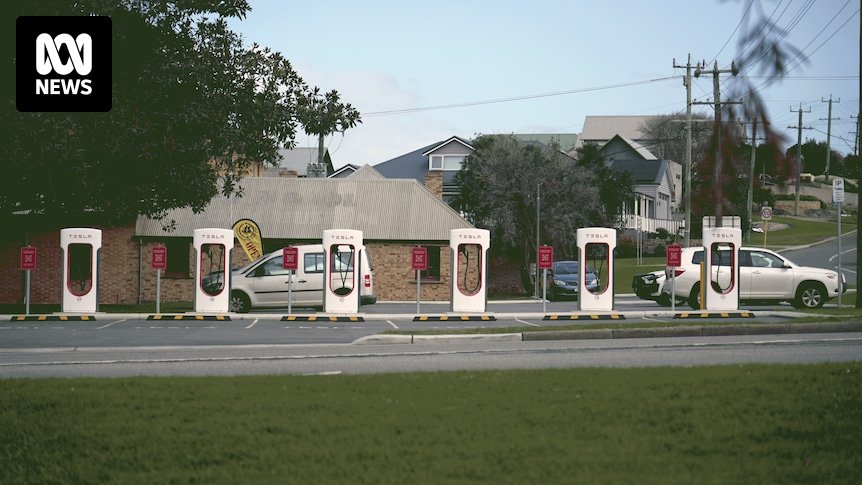Peter Petrovich would be the first to admit he’s not your ordinary consumer.
He is, as the economists would tell you, an early adopter of all things tech.
It’s one of the reasons he bought his first electric vehicle – or EV – a full 10 years ago when the industry in Australia was in its very infancy.
But there are others besides, as the Perth-based father-of-two explains.
“The torque that you get instantly from an electric motor, there is no Bugatti, there is no Lamborghini, there is no Ferrari that can match that,” Mr Petrovich says, in reference to some of the fastest petrol-powered cars in the world.
“Different people come to EVs from different perspectives.
“Some love it because it’s a computer on wheels. Others love it for the environmental aspect. Some love the performance.
“For me, it was the total package.”
For a whole host of reasons, the uptake of electric vehicles in Australia is steadily climbing.
While the numbers dipped slightly compared with the previous quarter, EVs made up more than 8 per cent of all new cars sold in the three months to June 30, according to the Australian Automobile Association.
In the same period in 2022, that number was just 1.12 per cent.
Facing a wall of demand
The rapid growth of sales is spurring expectations EVs will soon become a major, if not dominant presence on Australia’s roads.
Under a target set by the federal government, half of all new car sales are supposed to be electric by 2030 – barely five years away.
Some jurisdictions are setting their sights even higher, with the ACT aiming for 80 to 90 per cent of light vehicle sales to be “zero-emissions” within the same time.
Those same cars are also expected to drive a massive increase in the demand for electricity for transport.
Ausgrid, which services more than 4 million people running the network of poles and wires from the Sydney CBD to the Hunter Valley, used a submission to a federal parliamentary inquiry to show just how much.
From about 20 gigawatt-hours a year now, Ausgrid said “annual energy consumption from EV charging” would rocket to “over 1,500GWh by 2028-29”.
It was a similar story from Endeavour Energy, which runs the poles-and-wires network across Sydney’s greater west and down to the New South Wales south coast.
Demand for EV charging in its network, Endeavour said, was forecast to jump from 48GWh “to 635GWh” over the same period.
Energy consultant Peter Kerr says the future direction of the transport industry seems clear.
He says internal combustion engine cars powered by fossil fuels such as petrol or diesel would increasingly be overtaken by EVs.
“I don’t think anyone disagrees with the notion that the long-term future is electric, at best hybrid,” says Mr Kerr, who runs ATA Consulting.
“But I think electric has proven its technologically advanced relative to ICE engines.
“Almost all the big manufacturers are pushing very hard to get their entire line-up electric.”
Mr Kerr says getting to grips with the coming wall of demand for power for transport would have profound consequences for the shape of the grid – and the costs borne by power consumers.
Electric cars, he notes, are not like most other electric devices.
He says their sheer size – and the amount of power they can require to be fully charged – puts them in a category all of their own.
“An Australian house, on average, uses about 20 kilowatt hours a day. A battery in a car, a typical sedan, would be three times that at least,” Mr Kerr says.
“It’s got a lot of juice in it.
“And when you get the big beasts, the electric RAMS and the electric Fords, they’re in the hundreds of kilowatts.
“So they are an enormous piece of kit.”
Steering EV owners away from the peak
The size of many EV batteries is looming as a key risk – and opportunity – in the switch to clean transport.
Andrew Blaver is the boss of energy transition and sustainability at state-owned WA poles-and-wires company Western Power.
Mr Blaver says there’s no denying the size of a typical EV battery and its capacity to put pressure on the grid if charged at peak times.
But he says there’s nothing inevitable about a blowout in peak demand caused by EV charging.
“It all depends on how and when customers charge,” Mr Blaver says.
“At the moment, customers can connect their electric vehicle in their standard power outlet, and that draws about the same amount of energy from the network as a kettle does.
“And that obviously means that the electric vehicle will take longer to charge.
“But there’s also a wall-mounted [fast] charger at the moment.
“That’s about the size of a large air conditioner. That could add 30 to 50 per cent demand to our network.”
For Mr Blaver, network companies have every incentive to steer consumers away from charging during the peak, which typically happens in the morning and the evening on either side of the work day.
He says the electricity system is awash with abundant solar power just about every day and encouraging EV owners to soak up that excess power would help smooth demand.
Not only would this shift demand away from the peak and towards times when there is plenty of supply, Mr Blaver says it would also help save consumers money.
“If we face a situation where lots of customers come home at the same time, plug in and charge at peak, then it’s possible that we would need to upgrade our electrical infrastructure in the distribution network to accommodate that,” he says.
“But I think what’s really, really important is, before we ever get to a scenario where we need to upgrade the grid, that really needs to be a last resort.
“We have to work with customers, work with other agencies … to really encourage charging behaviour to be outside of peak times, use all that excess renewable energy.”
Batteries could aid the system
A more tantalising, longer-term prospect is also in sight, reckons Mr Blaver.
In energy boffin circles, they refer to it as “vehicle-to-grid”.
In layman’s terms, Mr Blaver says it amounts to the use of EV batteries – in their hundreds, thousands or even, eventually, millions – to buttress the grid from the shocks and pressures that inevitably arise.
“Ultimately, we also have an emerging technology, which is vehicle-to-grid,” Mr Blaver says.
“We could actually utilise energy or excess energy stored in batteries — customer home batteries or electric vehicle batteries — to access that energy, release it at peak time, which would further release the pressure of that demand from charging on the grid.”
For all the promise and potential of using consumers’ car batteries to help support the grid, Mr Blaver acknowledges there are misgivings about the concept, too.
Automakers such as industry flagbearer Tesla have famously resisted it, while there are doubts about whether consumers will want third parties tapping their car’s battery.
Mr Kerr agrees there are big assumptions underpinning the idea of vehicle-to-grid.
But he also points out that not every EV owner or automaker has to be on board for the concept to work.
“I don’t think there’s a single bullet in any of this transition,” Mr Kerr says.
“And I think some people will be reluctant to let their batteries free under the control of a great overseer of the market.
“I’ve seen it personally in some electricity trials, where people were given the opportunity of a free home battery, if they allowed the battery to be controlled by the utility to test out how does the network operate with these distributed batteries.
“And they refused a free battery. They did not want people controlling their life.
“If you get 75, 80 per cent of all cars participating, or home batteries participating, that’s an enormous amount of energy.”
In the meantime, Mr Kerry says there are relatively easy steps poles-and-wires companies can take to prepare for the EV revolution.
Among them, he says, is putting power lines underground.
“You can future-proof sometimes the network’s by taking overhead lines, the poles and wires you might see outside your house and burying them underground with new cables,” he says.
“And those new cables are bigger typically, so they can carry more juice, more electricity.”
Perth EV owner Peter Petrovich, for one, is optimistic Australia can navigate the road towards cleaner transport safely and sensibly.
“I don’t think EVs will present a problem for the grid as long as they’re managed responsibly,” Mr Petrovich says.
“When I ordered our first EV back in 2014, even back then, people were asking me about the effect that a large number of EVs would have on the grid.
“What I used to say to them back then is at the turn of the last century, when we were going from horse and carriage to motorcars, there were similar concerns around us not having enough iron and steel and rubber to supply all the motorcars.
“We supply almost 100 million cars every year. So obviously, those concerns were unfounded.”




